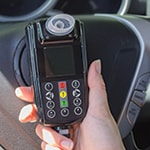Increasing Alcohol Ignition Interlock Use
Keep your state safe—increase alcohol ignition interlock use*
Ignition interlocks reduce driving while impaired (DWI) repeat offenses by about 70% while they are installed. All states have implemented ignition interlock programs to manage interlock issues and monitor offenders who are required or eligible to install them. Despite these laws and programs, only about one-fifth of those arrested for DWI have interlocks installed.
More comprehensive ignition interlock laws are known to be effective in decreasing the number of impaired drivers in fatal crashes.1 Laws requiring an ignition interlock for all offenders were associated with 26% fewer alcohol-impaired (0.08 g/dL BAC) drivers in fatal crashes compared with no interlock law during 2001–2019; laws requiring an ignition interlock for repeat and high-BAC offenders were associated with 20% fewer alcohol-impaired drivers in fatal crashes compared with no law during 2001–2019.1
What is an alcohol ignition interlock?

An alcohol ignition interlock is a breath-test device connected to a vehicle’s ignition. The vehicle will not start unless the driver blows into the interlock and has a blood alcohol concentration (BAC) below a pre-set limit, usually 0.02 g/dL.
How can states increase alcohol ignition interlock use?
States may consider the following eight key program features that can be used to strengthen state alcohol ignition interlock programs. These key features were identified through a collaborative evaluation§ that looked at characteristics of existing state interlock programs associated with increases in interlock use. Implementing just one of these key features is likely to increase interlock use. Implementing multiple key program features is associated with even higher increases in interlock use.
Eight key program features for strong state alcohol ignition interlock programs
| Key Program Feature | Characteristics of a Strong Program | Example |
|---|---|---|
| Require or incentivize use | Requirement or strong incentive to install interlocks | A law covering all offenders with significant reduction of hard license suspension period if interlock is installed |
| Levy strong penalties | Strong, swift, and appropriate penalties | Extension of interlock time, home monitoring, fail breath test, or tamper or otherwise circumvent interlock |
| Monitor interlocks to ensure proper use | Careful monitoring to assure interlocks are installed and used as intended | Random checks by Department of Motor Vehicles (DMV), probation, or treatment centers to ensure offender has installed and is using an interlock |
| Implement uniformly across state | Uniform and consistent implementation, statewide | All agencies report data regularly in compatible format, using uniform definitions of violations in same time frame |
| Coordinate across agencies | Close coordination and communication across all agencies | Regular communication with representatives from all interlock program-involved agencies |
| Educate stakeholders about the program | Regular training or education for all interlock agency staff and management | Regular trainings between interlock program managers, law enforcement, vendors, DMV, and court staff |
| Provide adequate resources | Adequate staff and funding resources | Designated interlock program manager and staff; financial assistance for offenders |
| Use data for action | Excellent data records (including level of offense, BAC level at time of arrest, number of prior arrests, installation/removal dates, violations) | Combined annual data on offenders available from all agencies to monitor offenders, report violators, and evaluate program effectiveness |
* Unless otherwise noted by a numbered reference, the content for this page comes from the report and fact sheet linked in the box below.
§ Key program features were derived from an evaluation conducted in 2014 by the Centers for Disease Control and Prevention (CDC), the National Highway Traffic Safety Administration (NHTSA), and the Governors Highway Safety Association (GHSA) and produced by the Preusser Research Group. The evaluation looked at key features of interlock programs and use of interlocks in 28 states from 2006–2011. Each state’s key program features were rated, and correlation analysis was used to determine which were related to higher interlock use. The full report contains additional data, analyses, discussion, and examples of strong key program features from various states.
- Read the full report: Evaluation of State Ignition Interlock Programs: Interlock Use Analyses from 28 States, 2006–2011
- Read the fact sheet: Increasing Ignition Interlock Use: Successful Practices for States [PDF – 8 pages]
- Read the journal article: Mandating Treatment Based on Interlock Performance: Evidence for Effectiveness
- Teoh ER, Fell JC, Scherer M, Wolfe DER. State alcohol ignition interlock laws and fatal crashes. Traffic Inj Prev. 2021;22(8):589–592. doi:10.1080/15389588.2021.1984439